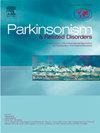Epigenomic profile of GBA1 in Parkinson's disease
IF 3.4
3区 医学
Q2 CLINICAL NEUROLOGY
引用次数: 0
Abstract
Introduction
While genome-wide association studies have identified GBA1 as a key gene contributing to disease severity and cognitive decline in PD, its molecular effects remain poorly understood.
Methods
We used integrative bulk ATAC-seq across six brain regions from autopsied individuals with PD and varying genetic risk to characterize region- and cell type-specific molecular differences. Using Cellformer, an AI-based bulk ATAC-seq-deconvolution tool, we determined cell type-specific effects of GBA1 on PD disease progression and then validated our findings using whole transcriptome data from blood samples.
Results
Epigenomic differences between PD with (“GBA+”; n = 15) and without (“GBA-”, n = 15) GBA1 variants were localized in substantia nigra. Nineteen chromatin-accessible regions strictly separated GBA+ from GBA-, including the promoter sites of key genes such as CACNA1C, EHMT1, and SLC25A48. The effect in GBA + spanned the main cell types in brain, and chromatin differences between GBA- and GBA + increased with neuropathologic progression of disease. Significant differences in the epigenomic profile in GBA+ were observed in neuronal cells (AUROC = 0.8, AUPRC = 0.8, P-value<0.0001). Validation in blood samples distinguished between GBA+ and GBA-subtypes, achieving AUROC values of 0.99. Over 5000 transcripts in blood cells distinguished GBA+ from GBA-, validating key genes and pathways from our epigenomic analysis of brain regions.
Conclusion
Our study provides novel insights into the cell type-specific epigenomic and transcriptomic landscape of GBA+ and its molecular divergence from other PD subtypes, and highlights potential therapeutic targets for this genetically defined subset of PD.
帕金森病中GBA1的表观基因组谱。
虽然全基因组关联研究已经确定GBA1是PD患者疾病严重程度和认知能力下降的关键基因,但其分子效应仍然知之甚少。方法:我们使用了来自PD和不同遗传风险的尸检个体的6个脑区域的整体ATAC-seq来表征区域和细胞类型特异性分子差异。使用Cellformer(一种基于人工智能的大量ATAC-seq-deconvolution工具),我们确定了GBA1对PD疾病进展的细胞类型特异性影响,然后使用来自血液样本的全转录组数据验证了我们的发现。结果:PD中(“GBA+”,n = 15)和不(“GBA-”,n = 15) GBA1变异的表观基因组差异局限于黑质。19个染色质可及区域将GBA+与GBA-严格分离,包括CACNA1C、EHMT1、SLC25A48等关键基因的启动子位点。GBA +的作用跨越了大脑的主要细胞类型,GBA-和GBA +之间的染色质差异随着疾病的神经病理进展而增加。结论:我们的研究为GBA+的细胞类型特异性表观基因组和转录组景观及其与其他PD亚型的分子差异提供了新的见解,并为这一遗传定义的PD亚群的潜在治疗靶点提供了新的见解。
本文章由计算机程序翻译,如有差异,请以英文原文为准。
求助全文
约1分钟内获得全文
求助全文
来源期刊

Parkinsonism & related disorders
医学-临床神经学
CiteScore
6.20
自引率
4.90%
发文量
292
审稿时长
39 days
期刊介绍:
Parkinsonism & Related Disorders publishes the results of basic and clinical research contributing to the understanding, diagnosis and treatment of all neurodegenerative syndromes in which Parkinsonism, Essential Tremor or related movement disorders may be a feature. Regular features will include: Review Articles, Point of View articles, Full-length Articles, Short Communications, Case Reports and Letter to the Editor.
 求助内容:
求助内容: 应助结果提醒方式:
应助结果提醒方式:


